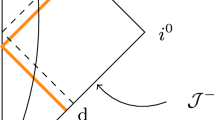Abstract
A (Higgs vacuum)–(spacetime geometry) reciprocity principle is proposed and its consequences are explored. While it has been established that configurations of the spacetime metric tensor field, associated with acceleration with respect to local inertial frames, cause the vacuum to become thermalized, it is asserted that the converse is also possible. An appropriate thermal vacuum, through dynamical mass generation, can cause particles to propagate in a spacetime with a Minkowski metric, as if they were in a spacetime with a non-Minkowski metric. The two points of view are equivalent and interchangeable. Invoking the reciprocity principle in the case of the Unruh effect in an accelerated frame, a mechanism is analyzed whereby in the context of the minimal standard model a gradient in the vacuum expectation value of the Higgs field in the direction of acceleration produces an effective inertial force on an accelerated material body.
Similar content being viewed by others
REFERENCES
S. W. Hawking, Commun. Math. Phys. 43, 199 (1975).
W. Israel, Phys. Lett. A 57, 107 (1976).
H. Umezawa and Y. Takahashi, Collective Phenomena 2, 55 (1975); H. Umezawa, H. Matsumoto, and M. Tachiki, Thermo Field Dynamics and Condensed States (North-Holland, Amsterdam, 1981).
W. Rindler, Essential Relativity (Springer, New York, 1977).
M. D. Kruskal, Phys. Rev. 119, 1743 (1960); G. Szekeres, Publ. Mat. Debrecen 7, 285 (1960).
P. C. W. Davies, J. Phys. A 8, 609 (1975).
W. G. Unruh, Phys. Rev. D 14, 870 (1976).
W. Moreau, R. Neutze, and D. K. Ross, Am. J. Phys. 62, 1037 (1994).
I. Newton, Principia Mathematica Philosophiae Naturalis (1686) (reprinted by University of California Press, Berkeley, California, 1934); G. Berkeley, The Principles of Human Knowledge, paragraphs 111-117 (1710); De Motu (1726); E. Mach, Conservation of Energy, note No. 1 (1872) (reprinted by Open Court, LaSalle, Illinois, 1911); The Science of Mechanics (1883) (reprinted by Open Court, LaSalle, Illinois, 1902), Chap. II, Sec. VI; H. Weyl, Naturwiss. 12, 197 (1924); D. W. Sciama, Sci. Amer. 196, 99 (1957); The Unity of the Universe (Anchor, New York, 1961), Sec. 21.12; C. Brans and R. H. Dicke, Phys. Rev. 124, 925 (1961); C. W. Misner, K. S. Thorpe and J. A. Wheeler, Gravitation (Freeman, San Francisco, 1973), pp. 543_549; H. Liu and B. Mashhoon, Ann. Phys. 4, 1 (1995).
J. A. Wheeler, “View that the distribution of mass and energy determines the metric,” in Onzième Conseil de Physique Solvay: La Structure et l'évolution de l'univers (Éditions Stoops, Brussels, 1959); Rev. Mod. Phys. 33, 63 (1961); “Mach's principle as boundary condition for Einstein's equations,” in Gravitation and Relativity, H.-Y. Chiu and W. F. Hoffman, eds. (Benjamin, New York, 1964); P. A. M. Dirac, Phys. Rev. 114, 924 (1959); R. F. Baierlein, D. Sharp, and J. A. Wheeler, Phys. Rev. 126, 1864 (1962); R. Arnowitt, S. Deser, and C. W. Misner, in Gravitation, L. Witten, ed. (Wiley, New York, 1962); C. W. Misner, Phys. Rev. 186, 1319 (1969); R. Gowdy, Phys Rev. Lett. 27, 286 (1971); K. Kuchař, Phys. Rev. D 4, 955 (1971); J. Math. Phys. 13, 768 (1972); J. W. York, Phys. Rev. Lett. 26, 1656 (1971); Phys. Rev. Lett. 28, 1082 (1972); J. Math. Phys. 14, 456 (1973).
B. Haisch, A. Rueda, and H. E. Puthoff, Phys. Rev. A 49, 678 (1994).
M. Sher, Phys. Rep. 179, 273 (1989).
C. W. Misner, K. S. Thorne, and J. A. Wheeler, Gravitation (Freeman, San Francisco,1973), Chap. 6.
T. H. Boyer, Phys. Rev. D 21, 2137 (1980).
S. Hacyan, A. Sarmiento, G. Cocho, and F. Soto, Phys. Rev. D 32, 914 (1985).
L. Dolan and R. Jackiw, Phys. Rev. D 9, 3320 (1974).
E. W. Kolb and M. S. Turner, The Early Universe (Addison–Wesley, Reading, MA, 1990), pp. 198-199.
P. Ramond, Field Theory: A Modern Primer, 2nd ed. (Addison-Wesley, Reading MA, 1989), Chap. 4.
S. Wolfram, Mathematica, 2nd ed. (Addison-Wesley, Reading, MA, 1991), pp. 576-577.
”Review of particle properties,” Phys. Rev. D 45 (1992).
Author information
Authors and Affiliations
Rights and permissions
About this article
Cite this article
Moreau, W. Dynamically Generated Inertia. Foundations of Physics 30, 631–651 (2000). https://doi.org/10.1023/A:1003728709237
Issue Date:
DOI: https://doi.org/10.1023/A:1003728709237



